Keywords
|
| D-statcom, Voltage source converter, Hysteresis current controller, Voltage sag, Interruption, Voltage swell. |
INTRODUCTION
|
| To overcome the problem related to the power quality custom power device is introduced. A number of power quality problem solutions are provide by custom devices. At present, a wide range of flexible AC controller which is capitalized on newly available power electronic components is emerging for custom power application. Among these distributions static compensator is used in the present work. The fast response of D-statcom makes it efficient solution s for improving the power quality in distribution system. Here the D-statcom used with different controller such as PI to improve the power quality under different abnormal condition, which causes the power quality related problem. Under the heavy load conditions, a significant voltage drop may occur in the power system. Voltage sags can occur at any instant of time, with amplitude ranging from 10-90% and a duration lasting for half a cycle to one minute. Voltage swell is less commonly occurs in distribution system. |
| D-statcom basically VSC based FACTS controller. It is employed at distribution level or at load side also behaves as shunt active filter. It works as the IEEE-519 standard limit. Since the electrical power distribution system it is very important to balance the supply and demand of active and reactive power in the electrical power system. Incase if the balance is lost the frequency and voltage excursion may occur result in collapse of power system. So we can say that the key of stable power system. The distribution system losses power quality problems are increasing due to reactive power. The main application of D-statcom exhibit high speed control of reactive power to provide voltage stabilization in power system .The D-statcom protect the distribution system from voltage sags, flicker caused by reactive current demand. |
| In this paper, it proposed Improved power quality is the driving force for today’s modern industry. Consumer awareness regarding reliable power supply has increased tremendously in the last decade. This has lead to an additional thrust to the development of small distributed generation. Small isolated DG sets have the capability to feed local loads and thus lads to improvement in reliability of power with low capital investment. These systems are also gaining increased importance in isolated areas where transmission using overhead conductors or cables is unrealistic or prohibitive due to excessive cost. Small generation systems in hilly terrains, islands, off shore plants, power distribution in rural areas, aircrafts etc can be efficiently utilized even in developing countries. However, these DG sets may have to be de-rated if induction motor loads are simultaneously started .One useful option is to use DSTATCOM in shunt configuration with the main system so that the full capacity of generating sets is efficiently utilized .DSTATCOM employs a voltage source converter (VSC) and generates capacitive and inductive reactive power internally. Its control is very fast and has the capability to provide adequate reactive compensation to the system. DSTATCOM can be effectively utilized to regulate voltage for one large rating motor or for a series of small induction motors starting simultaneously. Induction motor loads draw large starting currents (5- 6times) of the full rated current and may affect working of sensitive loads. |
DISTRIBUTED STATIC COMPENSATOR (D-STATCOM)
|
| D-statcom (Distributed static compensator) is a parallel voltage controller, which is schematically depicted in figure- 1, consists of a filter, Voltage source converter, a dc energy storage device, a coupling transformer connected in shunt to the distribution network through a coupling transformer. The voltage source converters the dc voltage across the storage device into a set of three-phase ac output voltages. These voltages are in phase and coupled with the ac system through the reactance of the coupling transformer. Suitable |
 |
| Fig. 1 Schematic diagram of D-statcom |
| Adjustment of the phase and magnitude of the D-statcom output voltages allows effective control of active and reactive power exchanges between the D-statcom and the ac system. Such configuration allows the device to absorb or generate controllable active and reactive power. The VSC connected in shunt with the ac system provides a multifunctional topology which can be used for up to three quite distinct purposes: |
| 1. Voltage regulation and compensation of reactive power; |
| 2. Correction of power factor; and |
| 3. Eliminating of current harmonics. |
| Here, such device is employed to provide continuous voltage regulation using an indirectly controlled converter. The shunt injected current Ish corrects the voltage sag by adjusting the voltage drop across the system impedanceZth. The value of Ish can be controlled by adjusting the output voltage of the converter. The shunt Ish can be written as, |
 |
| It may be mentioned that the effectiveness of the D-statcom in correcting voltage sag depends on the value of Zthor fault level of the load bus. When the shunt injected current Ish is kept in quadrature with VL , The desired voltage correction can be achieved without injecting any active power into the system. On the other hand, when the value of Ish of minimized, the same voltage correction can be achieved with minimum apparent power injection into the system. |
VOLTAGE SOURCE CONVERTER (VSC)
|
| A Voltage source converter power electronic switch are used like IGBT/GTO, Here the power electronic switches to operating at finite switching frequency and withstanding the high voltage rating, regarding that we choosing by the Insulated Gate Bi-polar Transistor (IGBT). Voltage Source Converter (VSC) is used for the injection of the controllable ac voltage and also generates a sinusoidal voltage with any required frequency, magnitude and phase angle. Voltage source converters are widely used in controlling application for various devices (i.e.) adjustable speed drives. It can also be used to mitigate voltage sags. It is used to either completely replace the voltage or to inject the missing voltage (the difference between the actual and nominal voltage is known as the missing voltage). The converter is normally based on some kind of energy storage, which will supply the converter with a DC voltage. The solid state electronics in the converter is then switched to get the desired output voltage. Normally the VSC is not only used for voltage sag mitigation, but also for other power quality issues, e.g. flicker, interruption, harmonics. |
RESULTS AND DISCCUSION
|
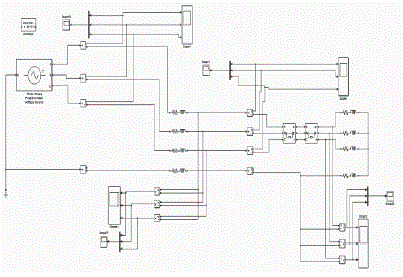 |
| Fig. 2 Simulation model without D-statcom |
| MATLAB/SIMULINK modeling of three phase loads without D-statcom as shown in Fig.2. The fault is created in source side, the corresponding waveform as shown in Fig.3. and fault time is mentioned as given below, |
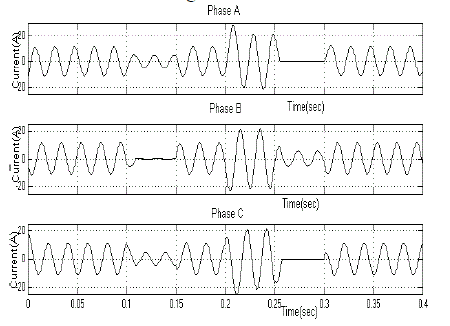 |
| Fig. 3 Current waveform without D-statcom |
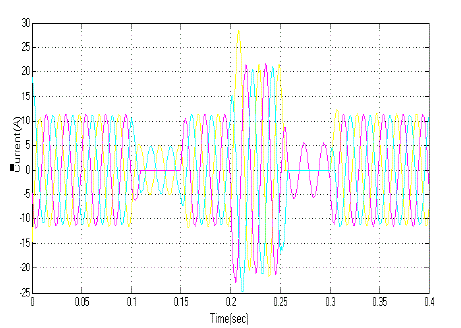 |
| Fig .4.Three phase Current waveform without D-statcom |
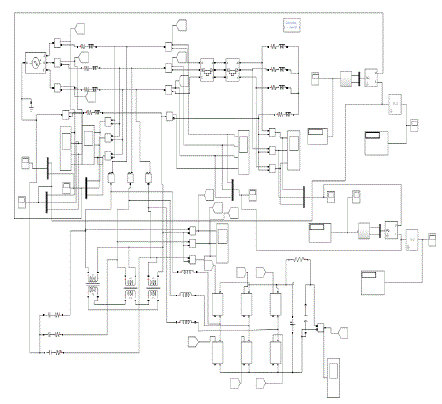 |
| Fig.5 Simulation model with D-statcom |
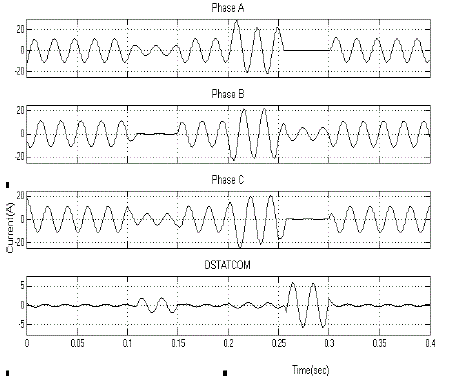 |
| Fig.6 Current waveform with D-statcom |
| The three phase current waveform as shown in Fig.4. The three single phase signals are combined by using multiplexer to create the three phase signal as mentioned above |
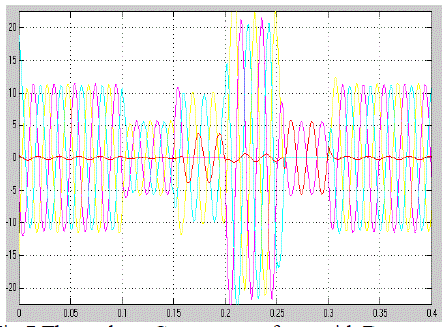 |
| Fig.7 Three phase Current waveform with D-statcom |
| The faults time periods like sag from 0.1 to 0.15 sec, swell from 0.2 to 0.25 sec and interruption from 0.25 to 0.3 sec. These above faulting periods to damage utility side loads, Hence to compensate these problems, we are used in Dstatcom. The corresponding three phase loads with D-statcom as mentioned above Fig.7. In transient condition fault current is produced, that fault current to affect or damage the voltage source converter. Hence to product the voltage source converter in D-statcom by using space vector pulse width modulation (PWM). The three phase current waveform as shown in Fig.7. |
POWER FACTOR COMPARISION
|
| Power factor comparison of source side and load sides as shown in Fig.8.The power factor level to improved in load side or utility side by using the D-statcom as mentioned the above figure. The directly source signal is supplying through the load to affect the sensitive loads and linear loads. These above problems to overcome by using D-statcom to improve the power factor in load side level. Similarly, it is also reducing the Total Harmonic Distortion (THD). |
 |
| Fig .8.Power factor comparison for source and load side |
CONCLUSION
|
| This paper has presented the power quality problems such as voltage sags, interruption, and voltage swell. The objective of work is to study the performance of D-statcom for mitigating voltage sag, interruption, and to improve the power quality in distribution network with non-linear load. The investigation is made on different condition for nonlinear load. In this work the investigation is composed of power system distribution system with and without Dstatcom. Power factor comparison for source and load side. So it can be concluded that D-statcom effectively improves the power quality in distribution network with non-linear load. |
References
|
- V.Malathi, “Power quality improvement of grid interconnected distribution system FSS-LMS algorithm”, VOL.02, Issue.06, ISSN: 2319-1163, Jun.2013.
- D.Bhanumurthy and Prashanth, “Power quality improvement at distribution level”,Proc.IJERA,vol.2,Issue.3,pp.970-975,Jun.2012
- Dr.S.R.Paranjothi and A.Selvaraj “Voltage Sag Mitigation on ASD”, Proc.IJEST,vol.3,no.02,ISSN:0975-5462,Feb.2011
- R Chiumeo and C Gandolfi, “Simulations of a possible configuration of Premium Power Park”, International Conference on RenewableEnergies and Power Quality (ICREPQ’10) Granada (Spain), 23-25th March, 2010.
- PinakiMitra and Ganesh Kumar Venayagamoorthy, “An Adaptive Control Strategy For DSTATCOM Application in an Electric Ship powerSystem”, IEEE Transaction on Power Electronics, vol25, no1,January 2010, pp95-104.
- Sunil Kumar and Bhim Singh, “Modified Power Balance Theory for Control of DSTATCOM”, IEEE Press, 2010, pp1-8.
- RS Bajpai and Rajesh Gupta, “Sliding Mode Control of Converter in Distributed Generation Using DSTATCOM”, IEEE Press 2010.
- Juan Segundo-Ramirez, Aurelio Medina and ArindamGhosh, “Stability Analysis Based on Bifurcation Theory of the DSTATCOMOperating in Current control Mode”, IEEE Transaction on Power Delivery, vol24, no3, July 2009, pp.1670-1678.
- Zhang Dongliang, Li Guoxin,WangChonglin and Tang jieJie, “Modeling and Simulation of DSTATCOM Based on Switch Function”,IEEE Press (ICIEA) 2009, pp2297-2301.
- HendriMasdi, Norman Marium and SMBashi, “Design of a Prototype DSTATCOM for Voltage Sag Mitigation”. European Journal ofScientific Research ISSN 1450- 216X vol30, no1, 2009, pp112-127.
|